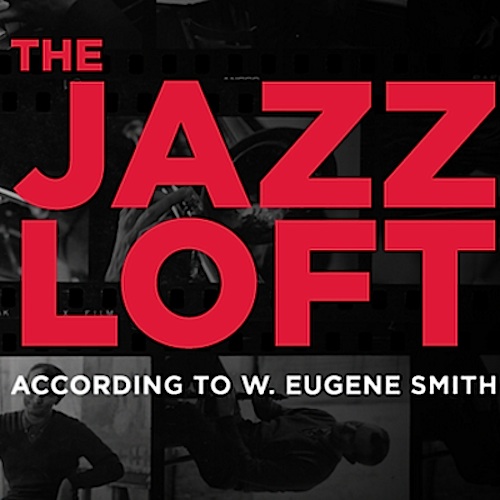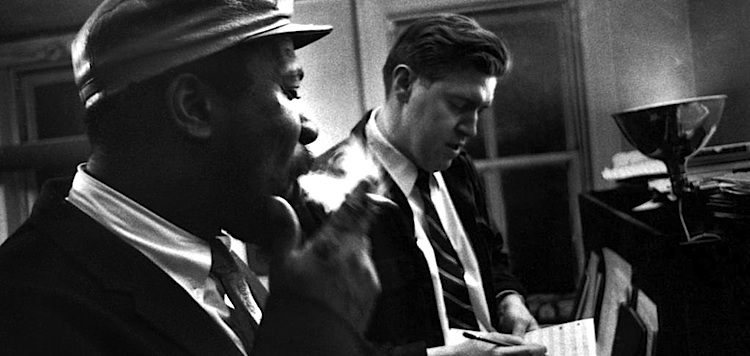By Joe Bendel. It was the jazz loft scene before the “Loft Jazz Scene.” In the mid-1970s, downtown lofts like Sam Rivers’ Studio Rivbea were an important venue for the fiery Free Jazz artists that were not getting commercial club bookings. They were sort of following in the tradition of W. Eugene Smith, who hosted round-the-clock jam sessions in his Flower District living space from 1957 to 1965. As a professional photographer and amateur reel-to-reel tape-recorder, Smith documented a great deal of the music and the comings and goings of the musicians drawn to his scene. Treasures from his chaotic archive are revealed in Sara Fishko’s The Jazz Loft According to W. Eugene Smith, the documentary component of WNYC’s multimedia Jazz Loft project, which screens during this year’s DOC NYC.
In the late 1950s, Smith was widely recognized as one of the nation’s leading photo-essayists, but like a good jazz musician, he badly mismanaged his career. Although not a musician himself, he shared a natural affinity for jazz artists, like his neighbor, Hall Overton. If jazz fans are having trouble placing that name, Overton was an accomplished jazz and classical composer who co-led sessions for Prestige with Jimmy Raney and Teddy Charles. He also arranged Thelonius Monk’s compositions for a ten-piece orchestra performance at Town Hall. Naturally, they rehearsed those demanding charts at the Sixth Avenue loft space, where Smith duly recorded them at work.
Fittingly, one of the musicians Fishko interviews is the great Freddie Redd, featured in both the Off-Broadway production of Jack Gelber’s The Connection and Shirley Clarke’s film adaptation. Indeed, its fictional narrative seems not so very far removed from events that transpired there. Unfortunately, that included heroin use, as drummer Ronnie Free explains in detail.
There is a lot of great music in Jazz Loft, but Fishko also gives Smith his due as a photographer. Thanks to his painstaking printing techniques, the contrast between light and shadow in Smith’s black-and-white images is often resembles Renaissance painting. In some ways, the film also functions as a time capsule, incorporating eccentric details of the late 1950s-early 1960s era, such as radio show hosted Long John Nebel, a sort of forerunner to Art Bell and George Noory, to whom Smith often set rather bizarre but expensive telegrams.
 In addition to Redd and Free, Fishko includes the reminiscences of Phil Woods (always a lively interview subject), David Amram (who seems like a nice fellow based on a few email exchanges), Carla Bley, Steve Swallow, Dave Frishberg, Bill Crow, and Overton’s colleague, Steve Reich, as well as some contemporary perspective from Jason Moran. That is quite a diverse but talented ensemble.
In addition to Redd and Free, Fishko includes the reminiscences of Phil Woods (always a lively interview subject), David Amram (who seems like a nice fellow based on a few email exchanges), Carla Bley, Steve Swallow, Dave Frishberg, Bill Crow, and Overton’s colleague, Steve Reich, as well as some contemporary perspective from Jason Moran. That is quite a diverse but talented ensemble.
Arguably, one point Fishko might have emphasized more was the stylistic openness of the sessions. Apparently Zoot Sims ruled the roost whenever he was in town, but Dixieland trumpeter Wingy Manone was equally welcome as his Hardbop, Bebop, and Swing colleagues. That was cool and very jazz. In fact, the entire film is a nostalgic, finger-snapping celebration of music and photography. At times, Jazz Loft is distinguished by a tone of clear-eyed sadness for the human weaknesses that sabotaged so many remarkable artists, but it is mostly just a swinging good time. Highly recommended hip eyes and ears, The Jazz Loft Scene According to W. Eugene Smith screens this Friday (11/13) at the Chelsea Bowtie and next Monday (11/16) at the IFC Center, as part of DOC NYC.
LFM GRADE: A
Posted on November 11th, 2015 at 7:34pm.
